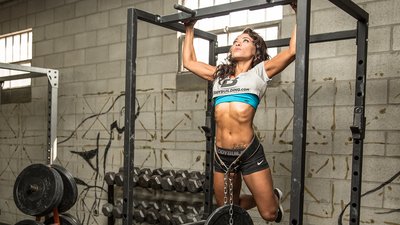Lifting heavy weights is as physical as it gets: It's just you against a heavy load. But if you hang around the gym long enough, you'll hear old-timers talk fondly about the mind-muscle connection and its benefits. The premise of this connection is that if you think about a muscle while you're training it, it's easier to recruit that muscle and make it grow.
New research by Brad Schoenfeld, PhD, CSCS, and Bret Contreras, CSCS, suggests that to maximize muscle growth, an internalized strategy of focusing on the muscle being trained "would increase activation of the target muscle," though the effectiveness is reduced when training at higher loads.1 At the very least, concentrating on what you're doing keeps you focused on the task at hand. That, folks, is always a good thing.
The modern gym is full of distractions—TVs, crowded spaces, and that phone in your pocket. Maintaining a focused mindset makes for productive training, but how does a lifter cut the distractions?
Try these smart strategies for cutting the malarkey and keeping your training focus!
1. Cueing Mantras
The meditative "om" is often misunderstood, but it's been used for centuries for a reason: It works. This simple, one-syllable utterance cuts away the outside world and gives a meditator the means to travel inward. We can use the same process to improve our exercise performance and focus.
The means are simple, and what I like to call "three-letter self-cueing mantras." Think about the most impactful tasks a lift requires: getting into the starting position, finding a good middle position, and performing the lift forcefully. Let's use the deadlift as the example.
You want to start, and finish the lift, tall and tight. You have to reach into a good bottom position before lifting, and you have to drive the floor away for a solid lift. The deadlift mantra, then, is TRD: Tall and Tight. Reach. Drive.
Cueing mantras are useful for any lift, and are limited only by the user's creativity. The outcome is profound. Repeating the three-letter cadence while preparing to perform keeps a lifter locked in the moment and focused on the details that make lifts successful—without overthinking.
2. Inter-Set Goals
Inter-set goals are versatile mind-focusing tools. To set them, simply select a simple, objective outcome that's challenging but attainable, and focus entirely on it during your set. These goals come in many forms, and like cueing mantras, are limited only by the user's imagination. Solid selections, however, include skill goals and performance goals. These are the time-tested staples. Let's examine an example of each:

Inter-set goals are versatile mind-focusing tools. To set them, simply select a simple, objective outcome that's challenging but attainable, and focus entirely on it during your set.
Skill goal: Let's say that you're a decent squatter, but you struggle with upper-body positioning and tightness. Specifically, you can't keep your elbows under the bar to maintain a tall and tight upper body. So, for the next set, you'd focus specifically on keeping your elbows under the bar and crushing the bar with your grip. Rather than focusing solely on the movement, you'd focus small and build a small skill that leads to a better squat. Focus on your lacking skill until it integrates into the movement. Then move on to your next weakness.
Performance goal: Setting a total-rep performance goal can help you maintain focus over an entire training session. You just set a number of reps and lift until you hit it! The key, however, is choosing the right exercise and rep range.
The exercise should be one that doesn't overwhelm your nervous system. Setting large, total-rep goals with the deadlift isn't a great idea—it's too much stress. Bodyweight pull-ups, however, work wonderfully. Next, just choose a rep total that's challenging but not ridiculous.
Let's say you've planned an upper-body workout that includes a few pressing lifts along with some pulling. You're adding in pull-ups to increase your training volume and attempt a total-rep goal.
Planning to include 100 pull-ups with the rest of your training will likely cause more harm than good, but if you cut that number in half, you have a challenging total-rep goal that productively adds volume to your training. (Of course, your number depends solely on your prowess with the exercise.)
It's best to choose exercises you're proficient at, so adding them to the session isn't too stressful. It's also important to avoid fatigue. Perform the pull-ups between sets of other lifts and only in nonfatiguing sets. If you know that 10 reps is your pull-up max, for example, shoot for sets of 4-5.
The focus on obtaining the goal over small increments keeps your mind centered on the training task at hand, minimizing distractions while also adding to your total training volume.
3. Reset Between Reps
Unless the goal is conditioning, don't rush your sets. Even if the focus is power, good rep setup leads to good performance. Lifters, however, often rush the reps of a set because they're focused on getting the set done rather than getting the most out of it. This is a case of focus being misplaced.

Unless the goal is conditioning, don't rush your sets. Even if the focus is power, good rep setup leads to good performance.
Resetting between reps is a great way to refocus. Rather than rushing and indiscriminately stringing reps together, you perform each individual rep with stout focus. The result is stronger lift performance—your mind stays focused on the task, and good positioning lets you heave more load.
Let's use the deadlift as an example. Rather than "touching and going" with each rep, keep the bar gripped, but reset alignment and tension after each rep. Return the bar to its resting position on the ground, then pull the hips into a good setup position and reset your back tension and grip. It should take just a second or two, and eventually will become second nature.
Keep Your Focus
We live in a world rife with distractions. Cut the extraneous noise with these focusing techniques. You'll have more productive training sessions and a refreshed mind when you leave the gym!

